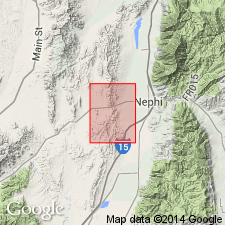
- Usage in publication:
-
- Orme Spring Conglomerate
- Modifications:
-
- Named
- Reference
- Dominant lithology:
-
- Conglomerate
- AAPG geologic province:
-
- Great Basin province
Summary:
Named for exposures near Orme Spring, Nephi NW quadrangle, Juab Co, UT, Great Basin province. Type locality is in northeast corner sec 31, T13S, R2W. Type area is SE1/4 sec 31, T13S, R1W. Reference localities designated in NW1/4 SW1/4 sec 33, T13S, R1W and in SE1/4 NE1/4 NW1/4 sec 35, T13S, R1W. Mapped in southern one-third of quad. One small exposure in north part of quad. Composed of conglomerate (75 to 90 percent) and local coarse sandstone lenses. Forms rounded knobs and low ledges. Conglomerate has clasts of fossiliferous (fusulinids) upper Paleozoic limestone, quartz, and calcareous sandstone that are subangular to subround in a matrix of medium- to coarse-grained, subangular to subround grains of quartz, quartzite, chert, and limestone. Thickness not stated. Unconformably? overlies Red Narrows Conglomerate. Unconformably underlies Chicken Creek Tuff Member (new) of Goldens Ranch Formation. Correlated with Flagstaff Formation and with Canyon Range Conglomerate. Of late Paleocene age [only, in text] on basis of correlation. Probably an alluvial fan deposit. May be of only local extent. [Shown on correlation chart as extending into the Eocene and as equivalent to Flagstaff and Green River Formations.]
Source: GNU records (USGS DDS-6; Denver GNULEX).
For more information, please contact Nancy Stamm, Geologic Names Committee Secretary.
Asterisk (*) indicates published by U.S. Geological Survey authors.
"No current usage" (†) implies that a name has been abandoned or has fallen into disuse. Former usage and, if known, replacement name given in parentheses ( ).
Slash (/) indicates name conflicts with nomenclatural guidelines (CSN, 1933; ACSN, 1961, 1970; NACSN, 1983, 2005, 2021). May be explained within brackets ([ ]).

